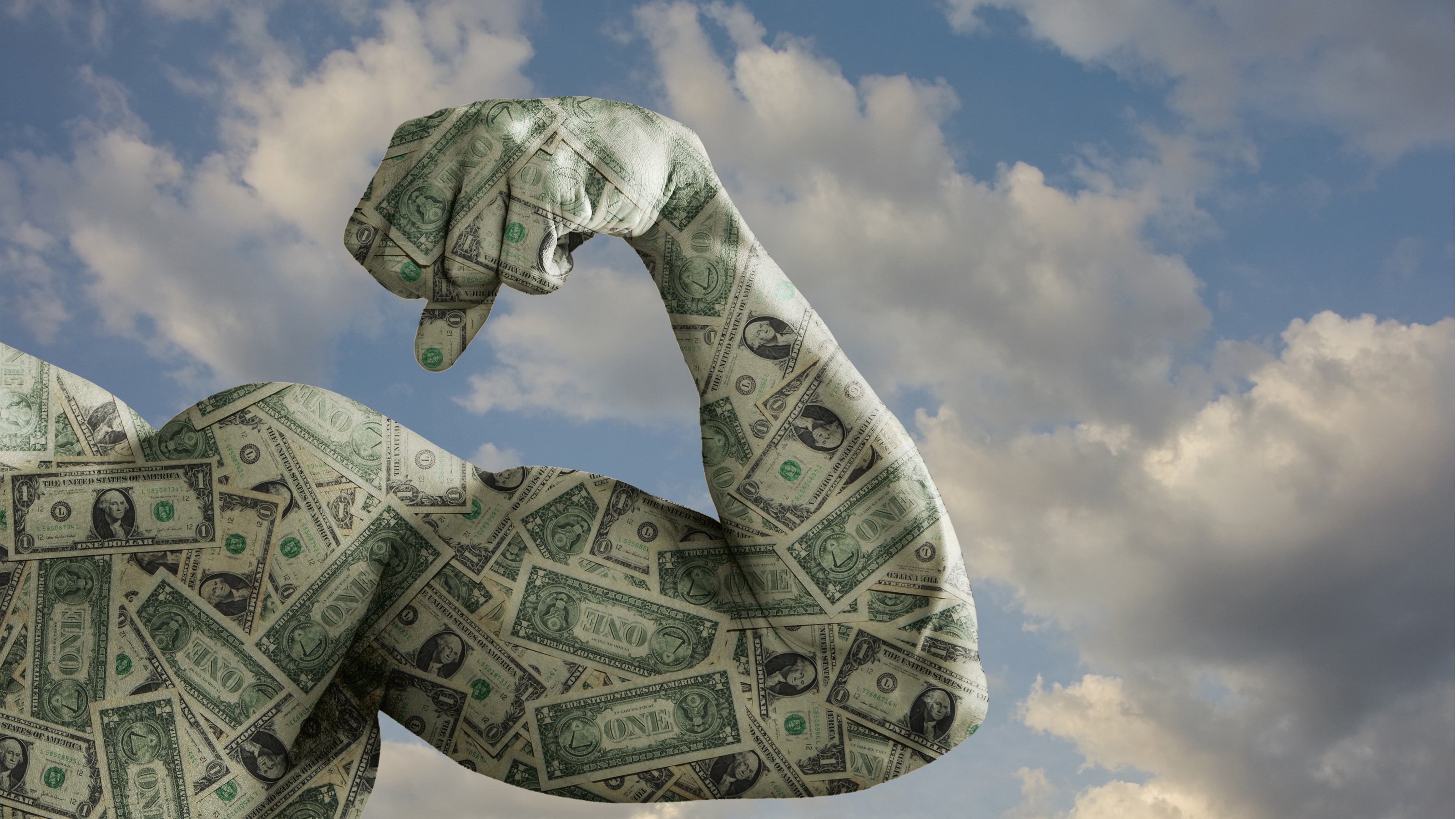Why a Strong U.S. Dollar Is Bad News for Investors
On top of higher inflation worldwide, corporate profits suffer when goods become more expensive at a time when other countries’ currencies are weaker against the U.S. dollar.


According to the U.S. Dollar Index, which measures the currency against a number of significant trading partners, including the euro, Japanese yen, British pound, Canadian dollar, Swedish krona and Swiss franc, the worth of the U.S. dollar has risen by nearly 9.3% during the past year. By comparison, the British pound plunged 11.2% over the past year.
"The greenback has gone ballistic," according to a Barron's piece in late September 2022, as the dollar hovered at a 20-year record high. Nearly every major currency lost value against the U.S. dollar throughout 2022 thanks to the Federal Reserve's campaign to rein in inflation with higher interest rates. The Fed is expected to continue regular rate increases into 2023.
While conventional logic would suggest a rising U.S. dollar bodes well during a period of runaway U.S. inflation, it is bad news for investors and the overall health of the American economy.
From just $107.88 $24.99 for Kiplinger Personal Finance
Become a smarter, better informed investor. Subscribe from just $107.88 $24.99, plus get up to 4 Special Issues

Sign up for Kiplinger’s Free Newsletters
Profit and prosper with the best of expert advice on investing, taxes, retirement, personal finance and more - straight to your e-mail.
Profit and prosper with the best of expert advice - straight to your e-mail.
Cons of the Strong U.S. Dollar
A strong U.S. dollar means lower costs for imported goods, which translates to less-expensive consumer items, but in the face of a record inflation and quantitative tightening, it only exacerbates the ongoing contraction on multinational corporations’ top and bottom lines. About 40% of the revenue in the S&P is international. The tech sector specifically is greater than 50%.
Troubling U.S. and Global Implications
To make matters worse, the Russian war in Ukraine coupled with the high U.S. dollar valuation is very troubling. Most commodities are priced in dollars. This makes necessities like oil and wheat more expensive, threatening the ability of some countries to access sufficient quantities of essential supplies.
The same is true of public debt. The high U.S. dollar value bumps up the cost of interest payments for foreign entities and citizens with U.S.-based loans.
And, while a stronger dollar is slowing the rate of inflation in the U.S., it is increasing the rate of inflation in much of the rest of the world. The global economy is weakening, as a result.
The situation we face is a double-edged sword. Unfortunately, there is no simple solution. Continuing inflation in the U.S. would mean higher costs for consumers. A stronger U.S. dollar helps limit inflation. Yet, a stronger dollar means less revenue coming from abroad to fuel the profits of U.S. companies.
The Strong U.S. Dollar Triggers Worldwide Inflation and Economic Risk
The dollar's surge has made difficult situations worse in the rest of the world. Central banks in other countries must raise interest rates in an effort to prop up their currencies. But the higher rates contribute to weakened economic growth and higher unemployment.
Citizens from Cairo to Istanbul to Manchester, England, and around the globe face life-changing inflation, which threatens their livelihood and ability to afford a place of residence.
Inflation makes imports to other countries more expensive, adding to their pressures. Companies, consumers and governments outside the U.S. that borrowed in dollars experience greater pressure — since more local currency is needed to convert into dollars when making loan payments.
The global economy is expected to fall into recession in 2023, due in part to the worldwide chain reactions resulting from the strong U.S. dollar.
The Strong U.S. Dollar and Investment Prospects
In a rising-dollar environment, foreign investments generally underperform.
And the price of U.S. stocks and bonds won't be as attractive to foreign investors, since they'll be more expensive when purchased with currency of lesser value. A significant subgroup of the S&P 500 are companies like Apple, Microsoft and Alphabet, which derive a substantial percentage of their revenue from overseas. These companies could experience valuation pressures as revenues subside.
Overall, the knock-on effects of an overly strong dollar environment mean price pressures for U.S. stocks. As one rises, the other drops.
But certain types of stocks typically do well when the dollar is strong. Generally, if the dollar's value increases, U.S. imports increase, while U.S. exports fall. So investing in the right industries that export to the U.S. could result in profits.
Though a strong dollar seems like a positive component of a healthy economy, globalization makes it a drag on U.S. markets and economic growth, among other perils, in this rough market environment.
Curbing inflation by raising interest rates is a necessary action, but it does upset the balance of the global economy and create a challenging situation for investors, which requires thoughtful insight.
Profit and prosper with the best of Kiplinger's advice on investing, taxes, retirement, personal finance and much more. Delivered daily. Enter your email in the box and click Sign Me Up.

Josh Sailar is an investment adviser and partner at Blue Zone Wealth Advisors, an independent registered investment adviser in Los Angeles. He specializes in constructing and managing customized advanced plans for business owners, executives and high net worth individuals. He holds the designations of Certified Financial Planner (CFP®) and Certified Plan Fiduciary Advisor (CPFA), the FINRA Series 7, 63, 65 licenses, as well as tax preparer license.
-
 Holiday Tax Scams: 'Tis the Season to be Wary
Holiday Tax Scams: 'Tis the Season to be WaryTax Scams Navigating tax tricks of the holiday season may be daunting, but don't let that destroy your festive spirit
-
 Metro by T-Mobile Is Giving Away This Samsung Galaxy A16: Which Plans Are Eligible?
Metro by T-Mobile Is Giving Away This Samsung Galaxy A16: Which Plans Are Eligible?Metro by T-Mobile is offering free Samsung Galaxy A16 phones on eligible plans right now. Here’s how the deal works.
-
 I Drive and Collect Classic Cars: Here’s How I Got Started
I Drive and Collect Classic Cars: Here’s How I Got StartedAre classic cars a hobby or an investment strategy — or both? Either way, the vintage car scene is much cooler and more affordable than you think.
-
 The $183,000 RMD Shock: Why Roth Conversions in Your 70s Can Be Risky
The $183,000 RMD Shock: Why Roth Conversions in Your 70s Can Be RiskyConverting retirement funds to a Roth is a smart strategy for many, but the older you are, the less time you have to recover the tax bite from the conversion.
-
 A Financial Pro Breaks Retirement Planning Into 5 Manageable Pieces
A Financial Pro Breaks Retirement Planning Into 5 Manageable PiecesThis retirement plan focuses on five key areas — income generation, tax management, asset withdrawals, planning for big expenses and health care, and legacy.
-
 4 Financial To-Dos to Finish 2025 Strong and Start 2026 on Solid Ground
4 Financial To-Dos to Finish 2025 Strong and Start 2026 on Solid GroundDon't overlook these important year-end check-ins. Missed opportunities and avoidable mistakes could end up costing you if you're not paying attention.
-
 Are You Putting Yourself Last? The Cost Could Be Your Retirement Security
Are You Putting Yourself Last? The Cost Could Be Your Retirement SecurityIf you're part of the sandwich generation, it's critical that you don't let the needs of your aging parents come at the expense of your future.
-
 I'm an Insurance Pro: It's Time to Prepare for Natural Disasters Like They Could Happen to You
I'm an Insurance Pro: It's Time to Prepare for Natural Disasters Like They Could Happen to YouYou can no longer have the mindset that "that won't happen here." Because it absolutely could. As we head into 2026, consider making a disaster plan.
-
 The Future of Philanthropy Is Female: How Women Will Lead a New Era in Charitable Giving
The Future of Philanthropy Is Female: How Women Will Lead a New Era in Charitable GivingWomen will soon be in charge of trillions in charitable capital, through divorce, inheritance and their own investments. Here's how to use your share for good.
-
 The November CPI Report Is Out. Here's What It Means for Rising Prices
The November CPI Report Is Out. Here's What It Means for Rising PricesThe November CPI report came in lighter than expected, but the delayed data give an incomplete picture of inflation, say economists.
-
 5 Smart Things to Do With Your Year-End Bonus, From a Financial Professional
5 Smart Things to Do With Your Year-End Bonus, From a Financial ProfessionalAfter you indulge your urge to splurge on a treat, consider doing adult things with the extra cash, like paying down debt, but also setting up a "fun fund."